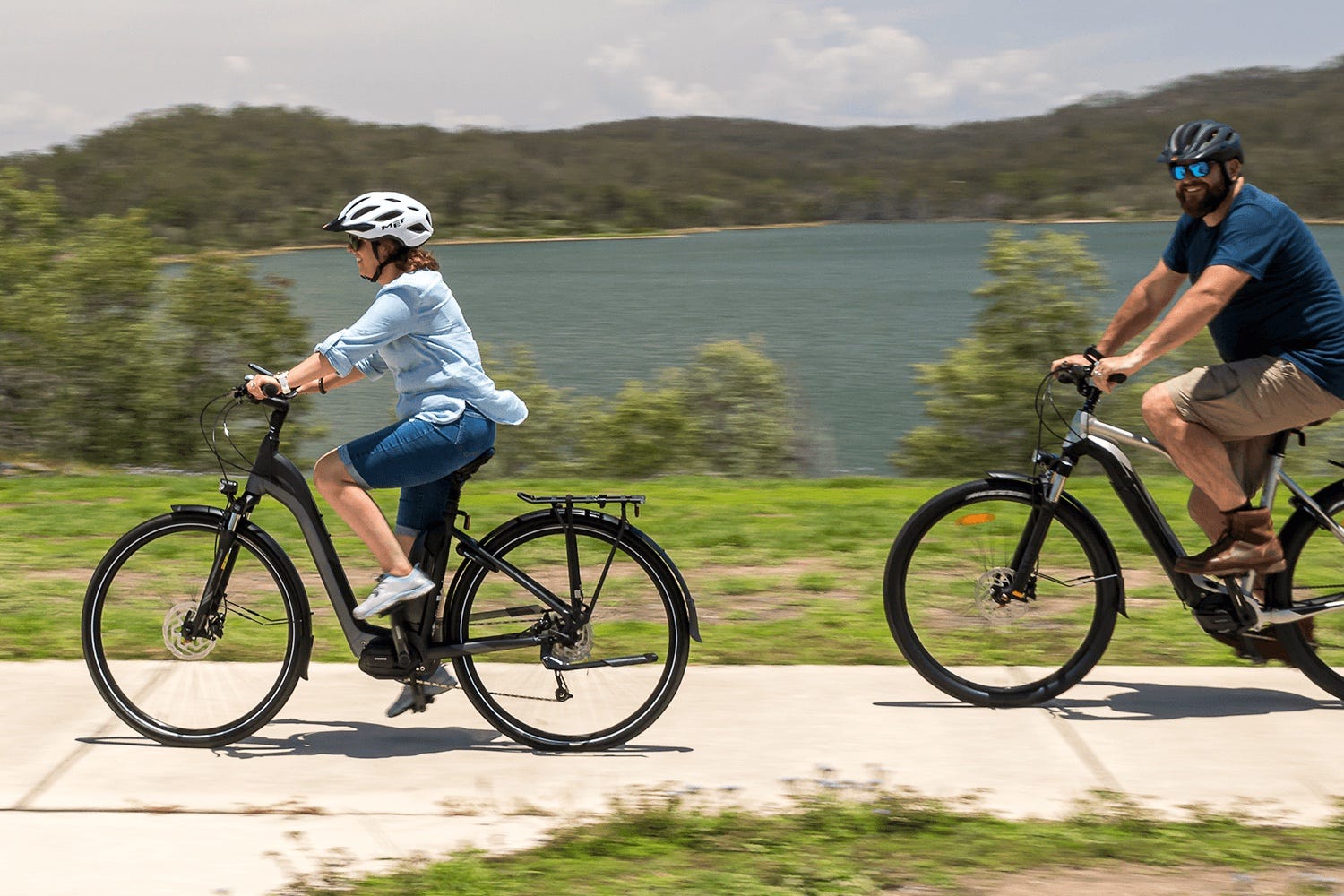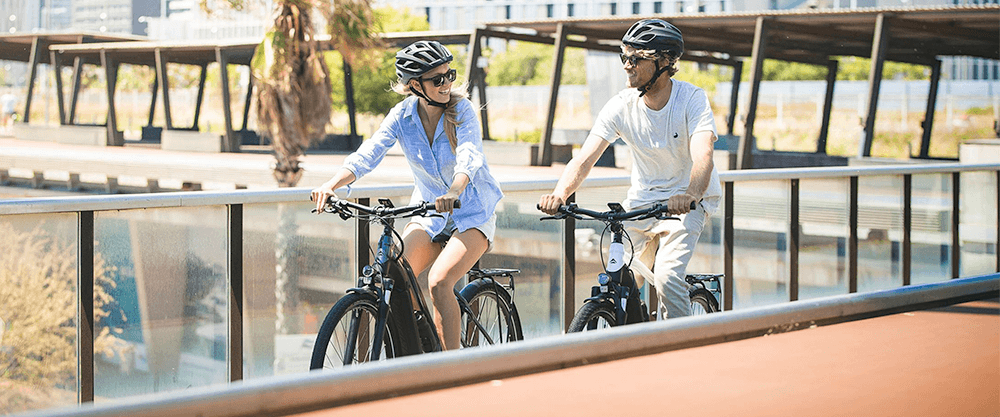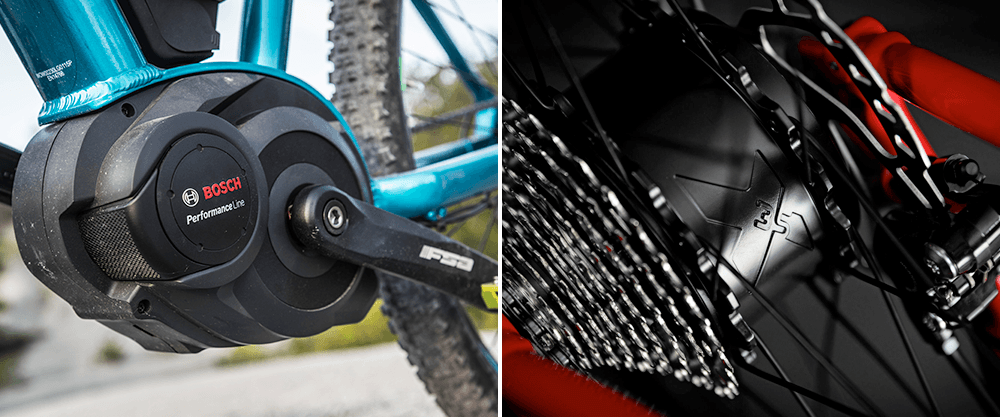Thinking About An E-Bike? Your Questions Answered By Our Experts

E-bikes are all the rage at the moment and make joining the world of cycling more accessible and enjoyable. However, if you've never owned an e-bike before, or it's just been a while, shopping for a new one can be overwhelming. There are hundreds of styles and lots of technical terms. Thankfully, our experts are here to help and have answered the most frequently asked questions about e-bikes, so you know what to look for.
Quick contents
WHAT E-BIKE BRANDS DO WE STOCK AT 99 BIKES?
What is an electric bike?

An electric bike is a bicycle that uses an electric motor to provide pedalling assistance. While you do still need to pedal, the motor kicks in to help once you start. It's there to lighten the effort required to pedal and uses a battery pack for power. Most e-bikes allow the rider to choose from varying levels of assistance. A small amount of aid makes your journey a little more effortless, while a higher level of assistance is excellent for tackling hills or cycling into a headwind. E-bikes are all the best bits of riding, with none of the bad ones!
Types of E-bikes
The Technical Stuff

Like many sports and activities, there are a lot of technical terms involved with e-bikes, which can be confusing, especially for new riders. Here's a breakdown of some of the most commonly used phrases and what they mean.
Volts (V)
The simplest way to think of volts in terms of e-bike performance is the 'horsepower' of the battery/motor. E-bike batteries typically come in 24V, 36V and 48V options. So again, like horsepower, more volts equals more power. Vroom vroom!
Amp-hours (Ah)
Amp-hours (Ah) is the most common unit for measuring the battery capacity in e-bikes. Comparing it to a car, think of it as the size of the petrol tank. Therefore, the more amp-hours a battery has, the longer the range (distance) you'll get from your e-bike.
Watt-hours (Wh)
Sometimes battery packs are quoted in watt-hours (Wh). For example, Bosch batteries are available in PowerPack300 and PowerPack400 options, which refers to the watt-hour capacity of the battery.
Watt-hours are a measurement of energy content, so a higher watt-hour rating will generally mean a longer range. However, this also depends on voltage, but it only needs some quick maths to work it out yourself. The formula is voltage multiplied by the amp hours equals watt-hours (V x Ah = Wh).
For example:
- Bike #1 has 24 Volts and a 20 AH battery = 480 watt-hours.
- Bike #2 has 48 Volts and a 10 AH battery = 480 watt-hours.
Despite the differing numbers, both bikes have similar energy on board. Therefore, if they have roughly equal motors and riders, they will likely perform similarly. However, a higher voltage bike may accelerate faster and climb better at the expense of some of that energy.
Torque (nm) rotational force
Torque is the measurement of power (rotational force) going through the cranks. It's usually measured in newton-metres (Nm), and on e-bikes, the torque can vary from 30Nm up to 95Nm. The higher the number, the less you have to use your legs.
Once you start moving the pedals, sensors detect the amount of load you're putting in and adjust the amount of assistance delivered to help you pedal. You can also change the amount on the head unit, but the higher the assistance level, the more power the bike will consume. So, controlling the assistance can extend the battery life in a ride.
Watts (Power)
Watts are the measurement of the potential power the electric motor can generate. Think of it like the engine size in a car. The higher the wattage, the more energy it can produce to assist you pedal. Cyclists will often measure and track their power performance in watts.
For example:
A 500Wh battery running a 250W motor at the maximum output will last 2 hours (500Wh divided by 250W equals 2 hours). Using the same battery but averaging 125 watts will now last 4 hours. How much effort the rider contributes or the mode selected drastically impacts the battery range.
What's the difference between watts and torque?
A racing car needs power (watts) to go fast, while a truck needs torque to tow a heavy load. Imagine two vehicles with the same weight and the same power are travelling at the same speed and start going up a hill. The one with less torque will have to change gear first.
Higher torque is excellent for EMTB motors since you're more likely to be going uphill on steeper terrain. Additionally, e-bikes are limited to 250watts and 25km/h, so a bike with more torque will hold that 25km/h speed for longer as the hill steepens.
What range can I expect out of an e-bike?
Several factors impact the range you'll get out of an e-bike. This includes the rider's weight, the mode you choose, the revolutions per minute (RPM) of your pedalling, the terrain you're riding on, and the wind. Most manufacturers will provide a general indication of the expected range, but it can vary.
For example:
- Velectrix foldaway has 313Wh (front hub drive) and a range of 30-40kms
- Merida eSpresso City has 500Wh (mid-drive) and a range of 60-90kms
- Cube Stereo Hybrid 160 HPC has 625Wh (mid-drive) and a range of 40-120kms
- Norco Sight VLT has 900Wh (mid-drive) and a range of 80-200kms
What is the difference between pedal assist and throttle control?
All electric bikes operate with pedal assist. However, some models have an extra throttle on the handlebar, which you can use to engage the motor – similar to pressing down on the accelerator in a car. The availability and use of these are subject to local state legislation.
What are the types of motors?
There are three main categories of motors: front hub, rear hub and mid-drive. Some motors will perform better on hilly terrain, while others will be more economical and suited for flat riding. Generally, the higher the torque, the better the steep terrain performance.
What E-bike Brands do we stock at 99 Bikes?
We have a wide range of electric bike brands available with different specs and price ranges.
Taking care of your E-bike

How often do I need to service an e-bike?
How often you need to service your e-bike will depend on how much riding you're doing. However, you should do it at least once a year, or every 1,000kms, depending on how and where you use your bike. Don't hesitate to chat to your 99 Bikes mechanic for tailored advice if you're unsure.
Regularly servicing your e-bike improves the longevity, ensures it's safe to ride, and checks that none of the parts are worn out. Services can also include firmware updates that enhance the smart functions, improve features, and add performance.
Can I ride my e-bike in the rain?
Yes, a little rain is fine for most e-bikes, but avoid deep puddles that will submerge the motor and battery – if it's flooded, forget it. Typically more expensive e-bikes handle wet weather conditions better due to superior electronics engineering.
How do I look after the battery?
As the battery is the single most expensive component on an e-bike, here are some helpful tips to get the most out of it.
- Avoid leaving the battery stored in hot temperatures, including in your car. In temperatures over 35 degrees Celsius, the battery may turn itself off due to overheating
- Try not to deplete the battery fully, as this will cause the battery voltage to drop below safe levels, which, in turn, can cause irreparable damage to the cells
- During long periods of storage and non-use, keep the battery about 2/3 (60%) full and top it up for two hours every eight to 12 weeks
How do I charge my e-bike?
If you have access to a powerpoint, you can charge your e-bike battery. Some e-bikes have batteries that you can detach for convenience but can also be charged on the bike. It's important to always use the supplied charger.
How long does it take to charge the battery?
The charging time depends on the battery. However, a battery typically reaches 70-80% charge in three hours, and to charge it fully, allow three to six hours.
How much does it cost to charge an e-bike?
One of the best things about an e-bike is the low running cost – the total amount to charge a typical battery is less than 15 cents!
Can I buy an additional battery? How much do they cost?
Yes, all the brands we carry have replaceable batteries, and some can be upgraded to a higher capacity for a greater range. Bosch and Shimano also have excellent faster-charging options available, which can be a great alternative to purchasing a spare battery. When it comes to pricing, Velectrix batteries range between $500-$800, while Bosch and Shimano range between $900-$1800.
What is the warranty for my e-bike?
Most e-bike motors and batteries (Shimano, Bosch and Velectrix) are covered under a two-year warranty.
How much does an e-bike weigh?
E-bikes are heavier than your standard bike and range between 14-25kg depending on the model, motor and battery. So you might need to consider this higher weight when choosing the right model for you.
Does my e-bike have a "Walk-Assistance" function?
Yes, most of our e-bikes have this handy feature. It provides a minimal level of power to make it easier to walk your bike around obstacles or push it to a particular location (such as out of the office and to the street). How you activate this function depends on the brand.
Now that you have the low-down on e-bikes and are feeling inspired, head into your local 99 Bikes store to speak to the experts. They'll be able to give you even more information and set you up with a free test ride so you can try one for yourself!
 Your store
Your store 







